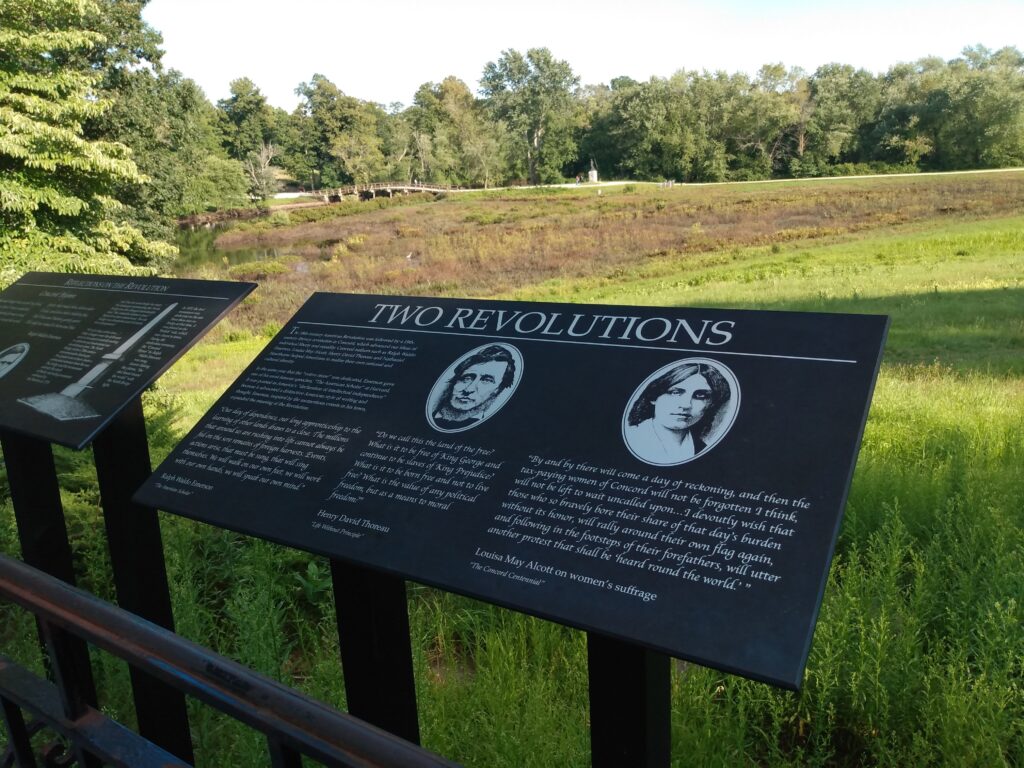
I was eager to get to Concord, but a late start to my morning meant that it made sense to take in Lexington first, which is less familiar to me. I found parking beside the town’s famous Green and wandered around getting my bearings, taking in the site where the American independence struggle began.

My next stop was Buckman Tavern on the corner of the Green. This gathering site for militia provides an overview of the start of the American Revolution. National identities were not formed in 1775, when tensions in the colonies had escalated to a point where the Britishregulars were sent to take charge of armements stored in Concord, and where American militia gathered to stop them. Paul Revere and William Dawes rode out from Boston on 18 April with the news of the coming troops. On the morning of the 19th, militia men were staged on the Green to meet the regulars. The redcoats were ordered not to fire upon the militia, but a shot rang out and the militia responded. Eight of them died there, one of them the owner of Buckman Tavern.
The next stop on the tour was the Hancock-Clarke House. On the night of the battle, Sam Adams and John Hancock were staying there and warned away by Paul Revere and William Dawes, who rallied there before heading to Concord. The site also offered a history of the Hancock family, explaining how John grew to leadership in the colonies and the role of the house during the events of 18-19 April.

My final Lexington stop was Munroe Tavern, which was commandeered by the regulars for treating the wounded and dead. The Munroes were patriots, but the tavern tells the events of the day from the British perspective. To be honest, they come away as fairly sensible, a government trying to remove weapons from an increasingly disgrunted colonial population then refusing to pay taxes. The battles at Lexington & Concord did not further the British cause, but served to inflame anti-British sentiment. By July, George Washington was named as commander of the rebel army and, within a year, the rebels would declare independence.

My day included two phone calls that disrupted my vacationing, so I headed to Concord much later in the day than I had hoped, tracing the path of the regulars, who turned toward Concord after the Lexington battle and arrived two hours later, making their way to the armament stores. The news of the battle on the Lexington Green and warnings brought out militia from across the area and they staged a fight at the North Bridge in Concord. Outnumbered, the regulars began to return to Boston and the militia began a war of attrition, using their knowledge of ground truth to wage war against the regulars. Reinforcements arrived from Boston by the end of the day, but the King’s men had suffered considerable losses.

It was my first visit to the North Bridge, and I was surprised at how close it was to the Old Manse, a site I had visited many years before. That is the Emerson family home where, during the Transcendentalist period, Thoreau planted the still thriving garden and Nathaniel Hawthorne’s wife Sophia used her engagement ring to trace her initials on the windows. In the times I had visited, I always came through the front of the house and was not aware that the backyard overlooks the site of the battle for Old North Bridge. The signs along the site point out the political and literary revolution that happened in the area and the back gate allows entrance to the house grounds.

I discovered that, thanks to Covid, many of Concord’s house museums were not operating on a full schedule. Hawthorne’s & Alcott’s Wayside was closed for the rest of my trip, which was a disappointment as I have never seen it. I had missed my chance to visit the Old Manse as well. I headed into Concord’s center and discovered it was pretty empty, so I headed to Walden Pond because it was open into the evening. I have been to Thoreau’s cabin site there before, so did not take time to walk out to it but wandered in and out of the pond. It was fun to join other vacationers before I found a motel for my last night in Massachusetts.

